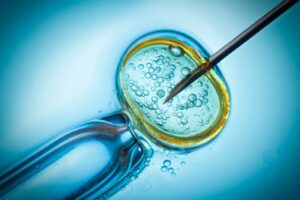I reflect here on our identity as sexed beings. In tomorrow’s essay I consider what it means for us to be gendered beings. But to do so, it is important first to make some distinctions concerning sex, intersex, and trans-sex on the one hand, and gender and transgender on the other.
The vast majority of human beings are born as members of one of the two sexes, male and female. In the paradigm case, those individuals are genotypically and phenotypically easily identifiable as one or the other, and their sexual identity is clear. But for a smaller number of individuals, things are not so obvious; the possibilities include individuals with ambiguous genitalia, mismatched genotype and phenotype, and perhaps some form of hermaphroditism.
The term “intersex” is now used to describe these cases. For some intersex persons, surgery is recommended and undertaken to bring phenotype and genotype into closer alignment with one another. But there is also debate within the medical community about what the proper treatment of genuine sexual ambiguity requires. Such questions do not fall within the scope of my consideration here.
For various reasons, some individuals, not in any obvious way manifesting sexual ambiguity, come to believe that they can and should change their sex. The terms “trans-sex” or “transsexual” are used to refer to the phenomenon of individuals who have undergone some form of medical intervention, typically including surgery and hormonal supplements, in an effort to make a change from the male to female sex or vice versa.
Start your day with Public Discourse
Sign up and get our daily essays sent straight to your inbox.Only males can father a child and only females can be a mother; these two functional roles are thus, as Charlotte Witt writes in The Metaphysics of Gender, “required for a society to exist.” On Witt’s account, gender is to be understood in terms of the two reproductive roles an “individual is recognized by others to perform,” and the content of the gender role is a matter of what norms are socially applied to persons in those reproductive roles. As she puts it, “Although I do not think there is a bright line distinction between sex and gender, the distinction is useful in explaining the difference between the biological function of reproduction and the socially mediated reproductive function.”
For various reasons, some individuals come to believe that they can and should change their gender. Depending perhaps on how early they have been encouraged to consider this possibility, they also can identify with a gender role other than that usually accompanying their sex, without any sense that they are changing genders. Since these decisions and identifications need not be accompanied by an attempt to change sex, such individuals are typically described as “transgender,” as distinguished from trans-sex.
All these phenomena raise questions of identity and morality, which are the topics of these essays. In this first essay, I examine the question of what sex is and whether it can be changed.
Our Sexed Identity
Our identity as animal organisms is the foundation of our existence as selves. But fundamental to our existence as this animal is our sex. We are male or female organisms in virtue of having a root capacity for reproductive function, even when that capacity is immature or damaged. In human beings, as is the case with many other organisms, that function is one to be performed jointly with another human being; unlike the digestive function, no individual human being suffices for its performance.
Accordingly, reproductive function in human beings is distributed across the two sexes, which are identified by their having the root capacity for one or the other of the two general structural and behavioral patterns involved in human reproduction. In male humans, this capacity is constituted by the structures necessary for the production of male gametes and the performance of the male sex act, insemination. In females, the capacity is constituted by the structures necessary for the production of oocytes and the performance of the female sex act, the reception of semen in a manner disposed to conception.
As noted above, there are persons who present genuine sex ambiguity. Some theorists of sex and gender have made much of these cases in arguing that the simple “binary” of male and female fails to do justice to the true number of sexes there are. And of course, opening up the number of possible sexes would add a certain plausibility to the proposed possibility of changing one’s sex.
This seems to be a failure to recognize the role of paradigm cases. The distinction, recognized since Aristotle, between the central case of a kind, and cases that in one way or another decline from that central case, has application outside the natural order. For example, Thomas Aquinas gives us an account of law as an ordinance of reason, given by one with authority, for the common good, and promulgated. This is the paradigm case, law in good working order. But it is easy to find examples of “law” that do not share all these features of the paradigm.
There are paradigm cases in the natural world also, as well as entities that decline from the paradigm. Organisms, for example, come in ones: that is part of the nature of what it is to be an organism, what it is to be an organism in the paradigm case. But the Hensel twins, possessing two arms and two legs but also two heads between them, are neither precisely one nor two. This case does not refute the claim about organisms coming in ones; neither, I conclude, do the varieties of sex-ambiguity refute the claim that in the central case of biological existence for members of our species, the organisms—and hence we—are either male or female.
Changing One’s Sex
Can it be reasonable or even possible to change one’s sex? Some who attempt to do so claim that their phenotypic (or genetic) properties are at odds with their real sex, which is understood (by them) to be a feature of some more primordial reality to which they have privileged interior access. Others deny that there even is such a thing as one’s “real” sex, and thus believe that a person can change it as he or she wishes.
If sex is to be understood in the way I have suggested, then it follows that every surgical attempt to change sex must involve a mutilation of the bodily capacity that identifies one’s true sex (such attempts must be distinguished, of course, from attempts to repair a damaged sexual capacity, and from attempts to resolve sex ambiguity). Moreover, since sexual capacity is what in turn capacitates us for marriage, understood as a one-flesh union, there is a further mutilation involved, insofar as such surgery incapacitates one from performance of an act necessary for the realization of the basic good of marriage. Since it is unreasonable to mutilate oneself or close oneself off from a basic good, attempts to change sex are unreasonable.
Nor does it seem to me that such a change is genuinely possible. A genuine sex change would make it possible for a male to engage in the kind of sex act characteristic of the female sex, or vice versa. Now a “sexual act” is identified by reference to the sex organs involved. So attempts to change sex (as opposed to gender, about which I have more to say tomorrow) are most plausibly pursued by attempts to change one’s sex organs.
But what those organ are—a penis or a vagina—can only be identified by reference to the role those organs typically play in the overall biological economy of a sexed human being. The penis typically penetrates the vagina but then also deposits sperm, which is in turn capable of procession towards and penetration of the female oocyte; the vagina is typically a receptacle and conduit of sperm to the oocyte, and so on. And both organs’ identities are linked not only forward in these ways to the functions they might eventually perform, but are also linked backward to previous events and functions. For example, the origin of male gametes is to be found in the production of primordial germ cells that occurs many years before sexual intercourse is even possible, but this production occurs in order that sperm will eventually be produced which the penis will eventually deposit. An organ lacking this historical role in the biological economy is not a penis.
One cannot therefore make a vagina, say, simply by creating an orifice in a particular place. Absent some relationship to a vagina’s larger biological functionality in the organism, no orifice is a vagina. Nor can one create a penis by creating something that will become enlarged on stimulation. One could only genuinely make a penis or vagina by re-creating the entire biological context within which those realities are what they are.
But those larger biological contexts are themselves not freestanding in the organism: The organism is primordially sexed from its very first moment, and its biological development involves the working out through time of capacities that were present at the beginning for the development of those organs in their appropriate contexts.
It is possible, as it turns out, to transplant a penis in a man so that it becomes truly part of his biological life. The situation is relevantly similar to that of a heart transplant. The organ is integrated into a biological matrix that is fundamentally oriented towards that organ’s presence. But no transplant, much less any reconstructive plastic surgery, can integrate a male sex organ into the biological life of a being whose root capacities are female, or vice versa. Nor is it possible that an entirely new set of capacities, dynamically oriented contrary to the orientation already worked out from within the organism’s biological identity, could be integrated into the life of that organism in such a way as to really be a part of his or her biological life.
Thus, attempts to change one’s biological sex all fail. That is an undefeatable reason against trying to do so.













